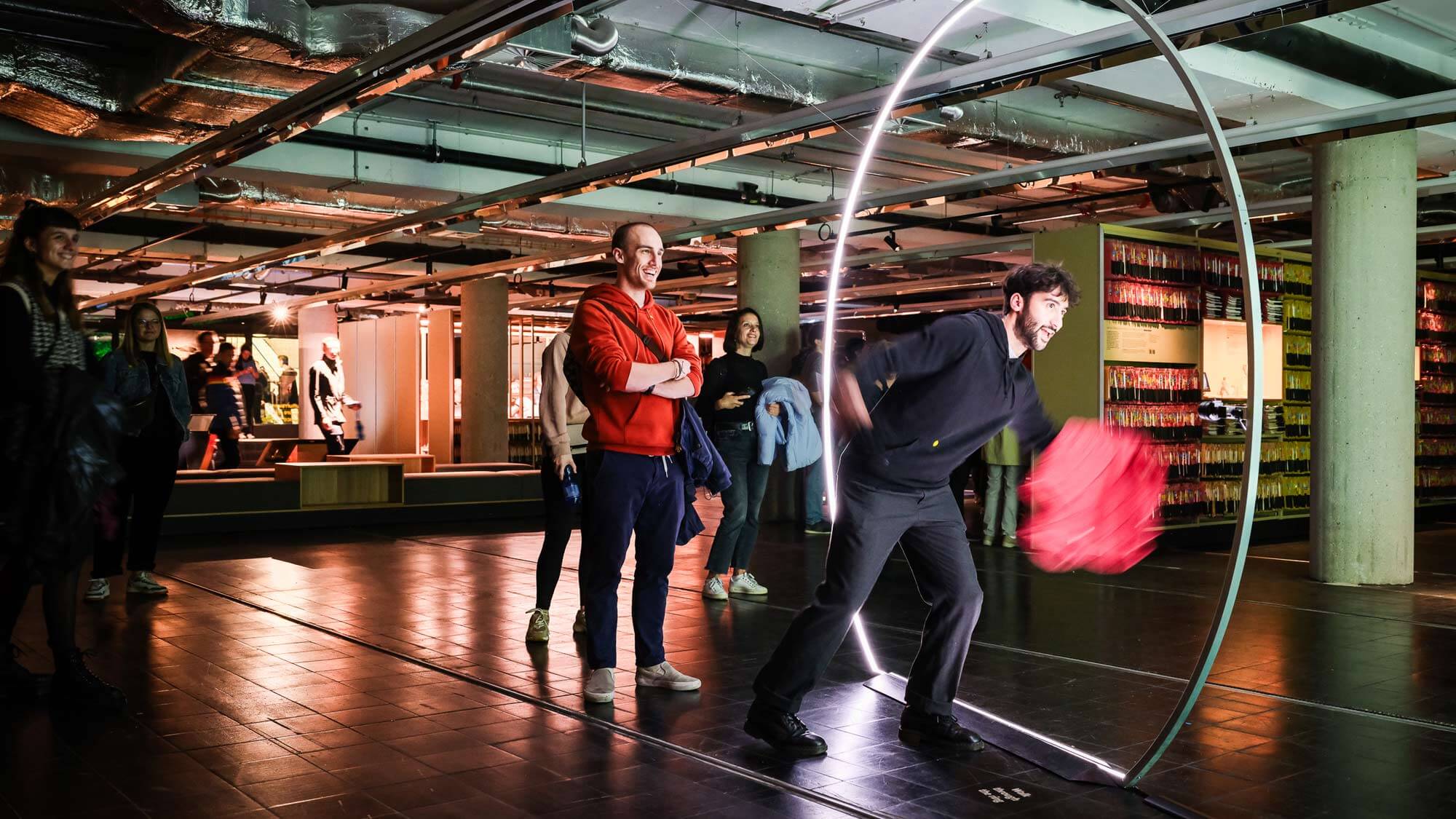Celebrating the 50th anniversary of the European Patent Convention, the EPO partnered with Ars Electronica to transform a former patent archive into a 1,000 m² exhibition space. The Catalyst lab explores global issues, from AI to sustainable tech, inviting visitors to rethink technology’s role in society.
Type: Exhibition
Opening: October 5, 2023
Duration: October 6, 2023 – June 15, 2024
City, Country: Munich, Germany
Venue: European Patent Office, Bob‑van‑Benthem‑Platz 1, 80469 Munich, Germany
To mark the 50th anniversary of the European Patent Convention, the European Patent Office (EPO) has invited Ars Electronica, to co-curate a central space in the basement of the EPO’s headquarters. The space – almost 1 000 m² – originally housed the registry for patent applications but when patent granting procedures were digitalised, it was no longer needed for this purpose. In the course of repurposing the basement, we worked together to develop a forward-looking concept for the use of the space that both preserves the original DNA of a patent archive and creates a special place for our staff and visitors to enjoy.
Big data, artificial intelligence and robotics, the production of materials and sustainable manufacturing, sleep as a climate technology, experiments with botanical life in space, data classification systems and blockchain, ecosystems with a human footprint – the exhibition Catalyst lab spotlights the global challenges of our time, examines the impact of technologies on our society and traces the rapid global changes driven by innovation and progress.
By perpetually striving for a higher quality of life, increased efficiency, greater cost-effectiveness and broader horizons, our civilisation is in a constant state of upheaval. With every technological advance and every instance of overcoming scientific boundaries, expanded spaces and possibilities shift our perspective on things and on our life situations. In order to understand the new dimensions of rapid technological influence on society in the digital age, the Catalyst lab appeals to our ability to evaluate innovation holistically on the basis of technological, societal and cultural values. In addition to a comprehensive understanding of the technologies themselves and wide-ranging public dialogue, this requires the incorporation of sustainability goals into the development of technologies, as well as the creation of an inclusive environment that promotes social cohesion.
Through the Ars Electronica exhibition, the EPO is taking the opportunity presented by the 50th anniversary of the European Patent Convention to look afresh at the pressing questions and issues of our time and inspire as many people as possible to reflect on and discuss them.
Artworks
Robertina Šebjanič (SI), Gjino Šutić (SI)
aqua_forensic

Water carries all sorts of information about human presence; and, in turn, humans have a major impact on aquatic environments. Anyone observing the movements of microorganisms in water will see a clear contrast between samples from areas heavily populated by humans and those from uninhabited areas. This video essay and book showcase recent art-science research: discover rarely seen worlds in water and the ‘monsters’ that inhabit them, as well as the connection between these habitats and our daily lives.
Bios
Robertina Šebjanič (SI) is an internationally exhibited artist. Her work explores the biological, chemical, (geo)political and cultural realities of aquatic environments. In her analysis of the Anthropocene, Robertina uses the terms ‘aquatocene’ and ‘aquaforming’ to describe human impacts on marine environments. Her works have received awards and nominations at Prix Ars Electronica, Starts Prize, Falling Walls and RE:Humanism.
Gjino Šutić (HR) is a biotechnologist, post-modern intermedia artist, innovator and educator. He is the founder and director of Universal Research Institute & Gen0 Industries. Gjino’s research spans biotechnology, bioelectronics, experimental electronics and ecological engineering. As an artist, he specialises in bio, digital, installation and hybrid art. He was awarded the gold prize for his work in synthetic chemistry and pharmacology at ARCA 2022 (the 20th edition of the International Exhibition of Inventions).
Artwork Credits & Acknowledgement
Artists (research & development): Robertina Šebjanič (SI) and Gjino Šutić (HR)
Project supported by: Ars Electronica within the EMAP/EMARE
Co-funded by the Creative Europe Programme of the European Union
Partners: UR Institute (HR), Sektor Institute (SI), Projekt Atol Institute (SI), Čistoća Dubrovnik (HR), The Ministry of Culture of the Republic of Slovenia and The Ministry of Culture of the Republic of Croatia
Artist Statement
aqua_forensic reveals how aquatic ecosystems are impacted by anthropogenic chemical pollutants that are invisible to the naked eye. Through a combination of art, science and citizen science, the multimedia work opens a discussion on the scope of human solidarity and empathy with aquatic environments. It draws on in vitro experiments conducted in 2018 on the banks of the Danube in Linz and the shores of the Adriatic Sea in Dubrovnik. The research and fieldwork show how traces of pharmaceutical products – including mood stabilisers, antibiotics, painkillers and hormone pills – can be seen to affect the behaviour of microorganisms in water samples.The complexity of marine and other aquatic ecosystems, which cover over 70% of the planet and are responsible for producing up to 80% of atmospheric oxygen, remains mysterious. Moreover, as anthropogenic pollution alters oceans, evolution is becoming irrevocably entangled with a global socio-technological system, shaped by (geo)political and economic interests in world waters. aqua_forensic explores the relationship between microbial life and the human ‘aquaforming’ of aquatic habitats, posing the question: How do rivers and oceans feel our impact?
Louis-Philippe Rondeau (CA)
LIMINAL
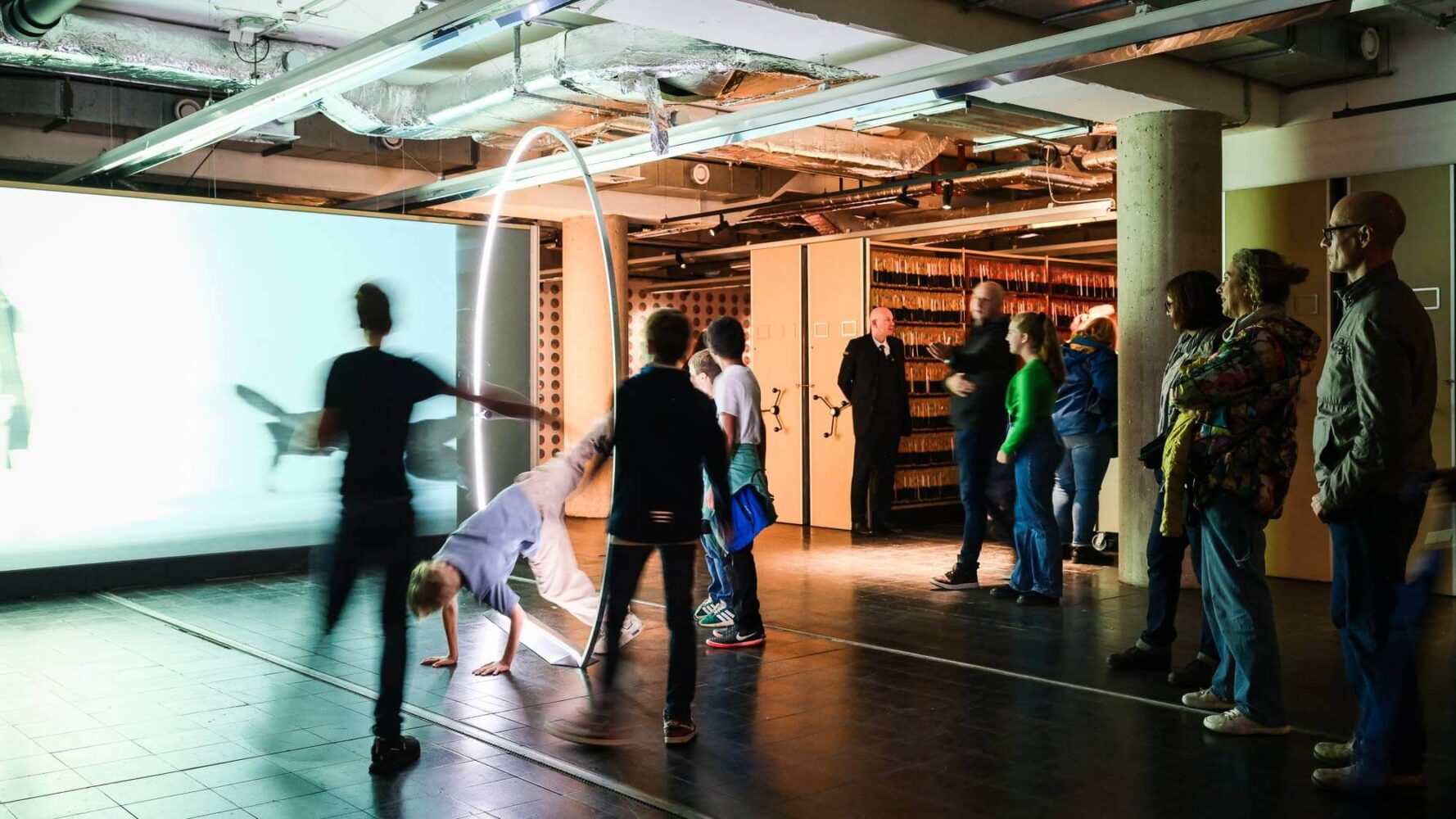
Embrace the fusion of decades-old technology and new perspectives in LIMINAL – an interactive installation that invites you to enter a live synergy of digital and physical worlds. Move your body and become a visual metaphor of time, accompanied by the soundtrack sculpted by your movements. Stepping through a portal is a ritual: now explore the ephemeral boundary between the present and the past!
Bio
In his works, Louis-Philippe Rondeau (CA) develops devices that explore self-representation and performance in a playful and unconventional manner. His research-creation approach renders a simplicity of design for users that conceals the complexity of computer code.
Artist Statement
LIMINAL is an interactive installation that embodies the inexorable passage of time. It seeks to manifest the distinction between the present and the past. An arch of light appears in the darkness: a portal. Cross the threshold, and your image is projected onto the adjacent wall, thanks to the use of a slit-scan technique also seen in cinema.In this visual metaphor – the present merges with the past – you see your image ebb and flow seamlessly amid the oblivion of white light. The work emphasises that all light is the manifestation of events that have already occurred – the twinkle we see in the night sky is but a bygone snapshot of a star. The sound from the setup is spatialised as the tone alters with your every movement and is sculpted by your gestures, encouraging you to vary your performance with every passing moment. Light transcribes improvised choreographies into images as your body is transformed by singular sensory experiences in time.
MaterialLab
This project focuses on the role of next-generation materials as the basis for new patterns of production and consumption. More sustainable and socially responsible manufacturing must be an absolute priority, especially while resource scarcity and poor working conditions remain a reality. Further, instead of relying on manufactured products, individuals could be empowered to produce more themselves.
The MaterialLab shelf system showcases samples of innovative material for you to view and the video documentary offers a deeper understanding of these materials. Engage your senses and get a feel for what the future holds.
MaterialLab projects:
- PEELSPHERE / Youyang Song (CN/DE)
- MyCera & Felix / Milena Stavrić (AT), Julian Jauk (AT), Hana Vašatko (AT), Lukas Gosch (AT)
- Reolivar (Earth/Air) / Naifactory Lab (ES)
- Interwoven / Diana Scherer (DE/NL)
Youyang Song (CN/DE)
PEELSPHERE
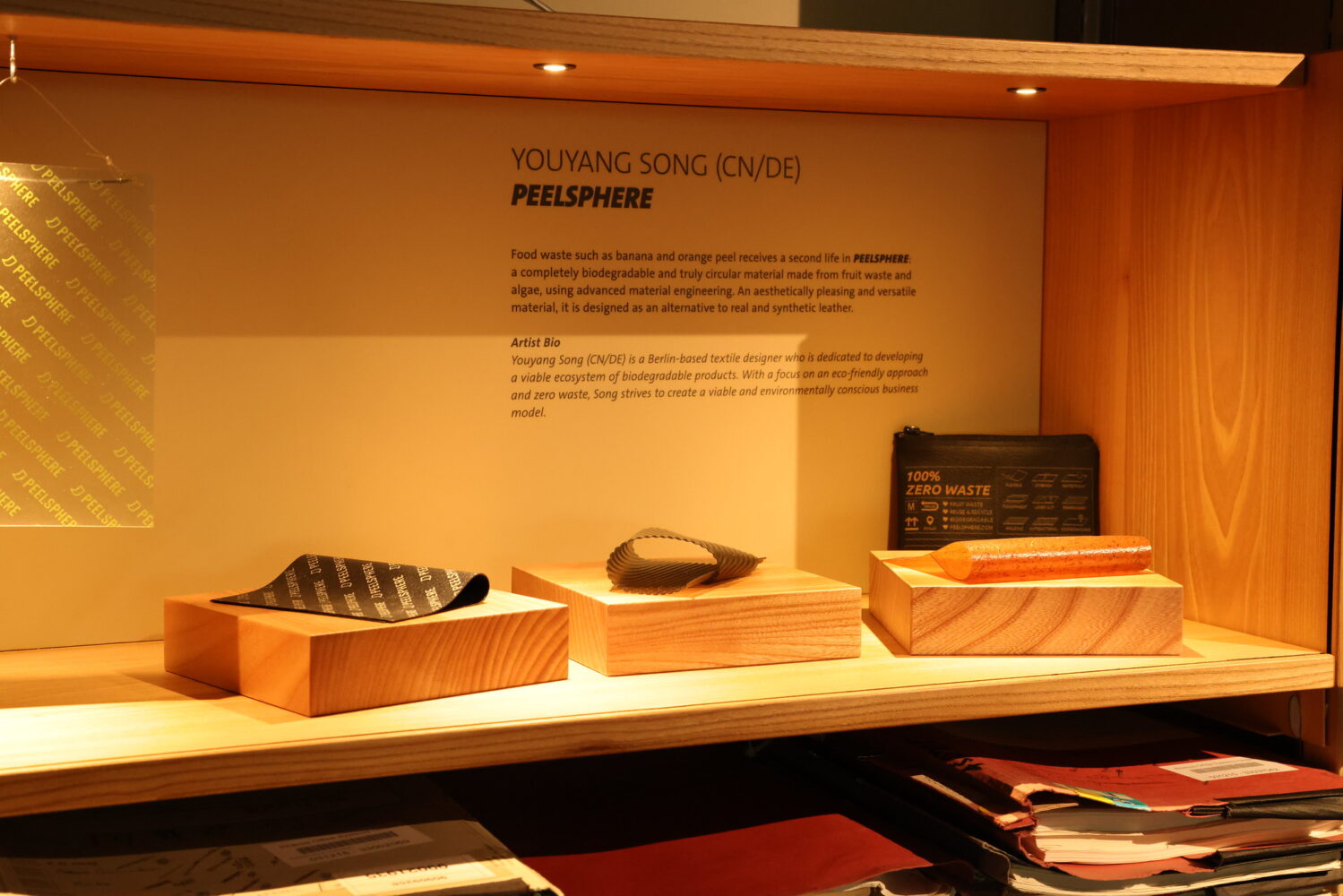
Food waste such as banana and orange peel receives a second life in PEELSPHERE: a completely biodegradable and truly circular material made from fruit waste and algae, using advanced material engineering. An aesthetically pleasing and versatile material, it is designed as an alternative to real and synthetic leather.
Bio
Youyang Song (CN/DE) is a Berlin-based textile designer who is dedicated to developing a viable ecosystem of biodegradable products. With a focus on an eco-friendly approach and zero waste, Song strives to create a viable and environmentally conscious business model.
Milena Stavrić (AT), Julian Jauk (AT), Hana Vašatko (AT), Lukas Gosch (AT)
MyCera & Felix
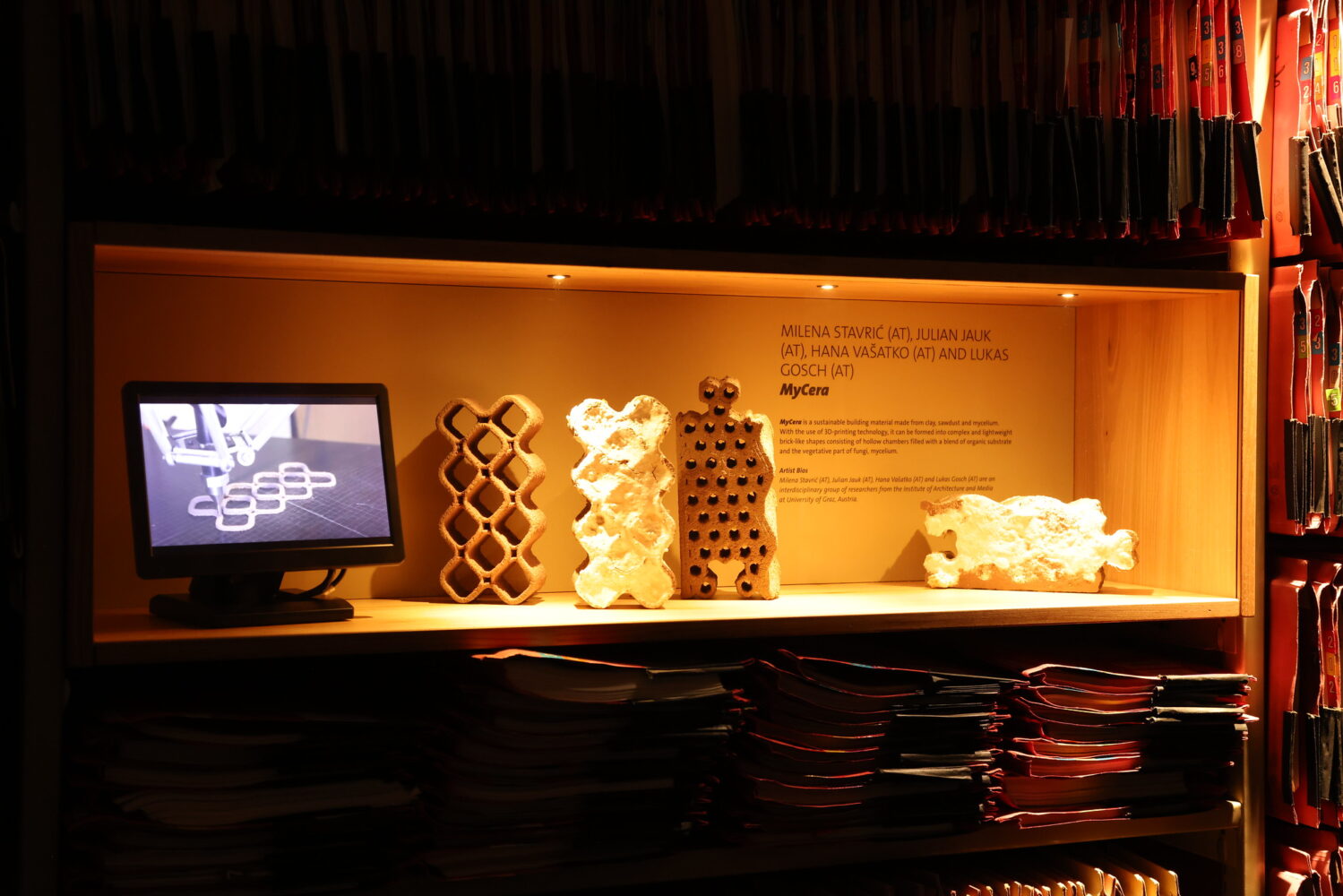
MyCera is a sustainable building material made from clay, sawdust and mycelium. With the use of 3D-printing technology, it can be formed into complex and lightweight brick-like shapes consisting of hollow chambers filled with a blend of organic substrate and the vegetative part of fungi, mycelium.
Felix is a module that has been developed both as an autonomous form, and to stack up to create a column or pillar. As such, it can be used to create new spaces while retaining a visually distinctive aesthetic of its own. In addition, its tube-like structure allows it to be filled with a substrate that is inoculated with mycelium. The living material acts as a binding agent and connects the stacked modules to create one solid piece.
Bios
Milena Stavrić (AT), Julian Jauk (AT), Hana Vašatko (AT) and Lukas Gosch (AT) are an interdiscipli-nary group of researchers from the Institute of Architecture and Media at University of Graz, Aus-tria.
Naifactory Lab (ES)
Reolivar (Earth/Air)
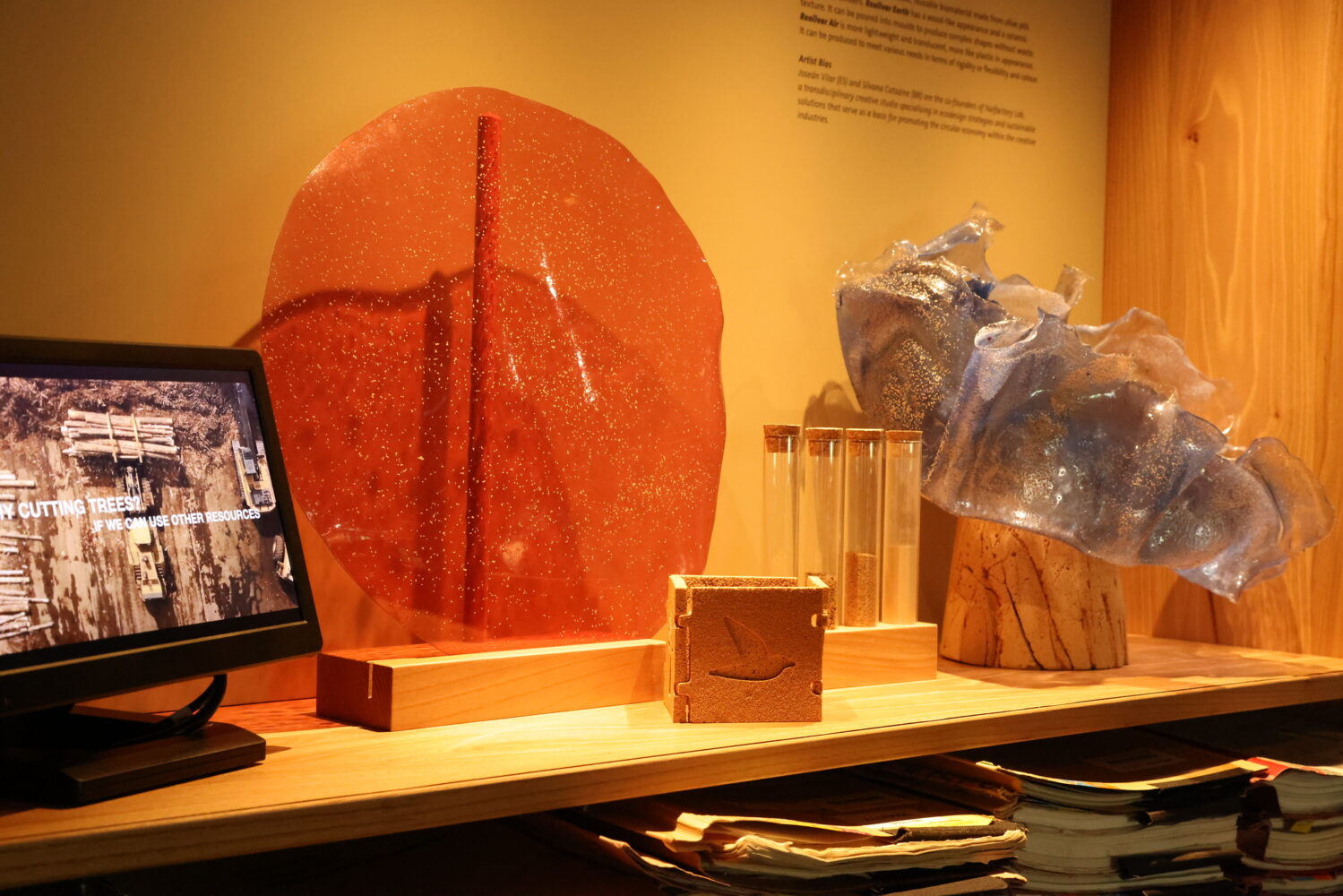
Reolivar is an organic, compostable, reusable biomaterial made from olive pits and natural binders.Reolivar Earth has a wood-like appearance and a ceramic texture. It can be poured into moulds to produce complex shapes without waste. Reolivar Air is more lightweight and translucent, more like plastic in appearance. It can be produced to meet various needs in terms of rigidity or flexibility and colour.
Bios
Joseán Vilar (ES) and Silvana Catazine (BR) are the co-founders of Naifactory Lab, a transdisciplinary creative studio specialising in ecodesign strategies and sustainable solutions that serve as a basis for promoting the circular economy within the creative industries.
Diana Scherer (DE/NL)
Interwoven
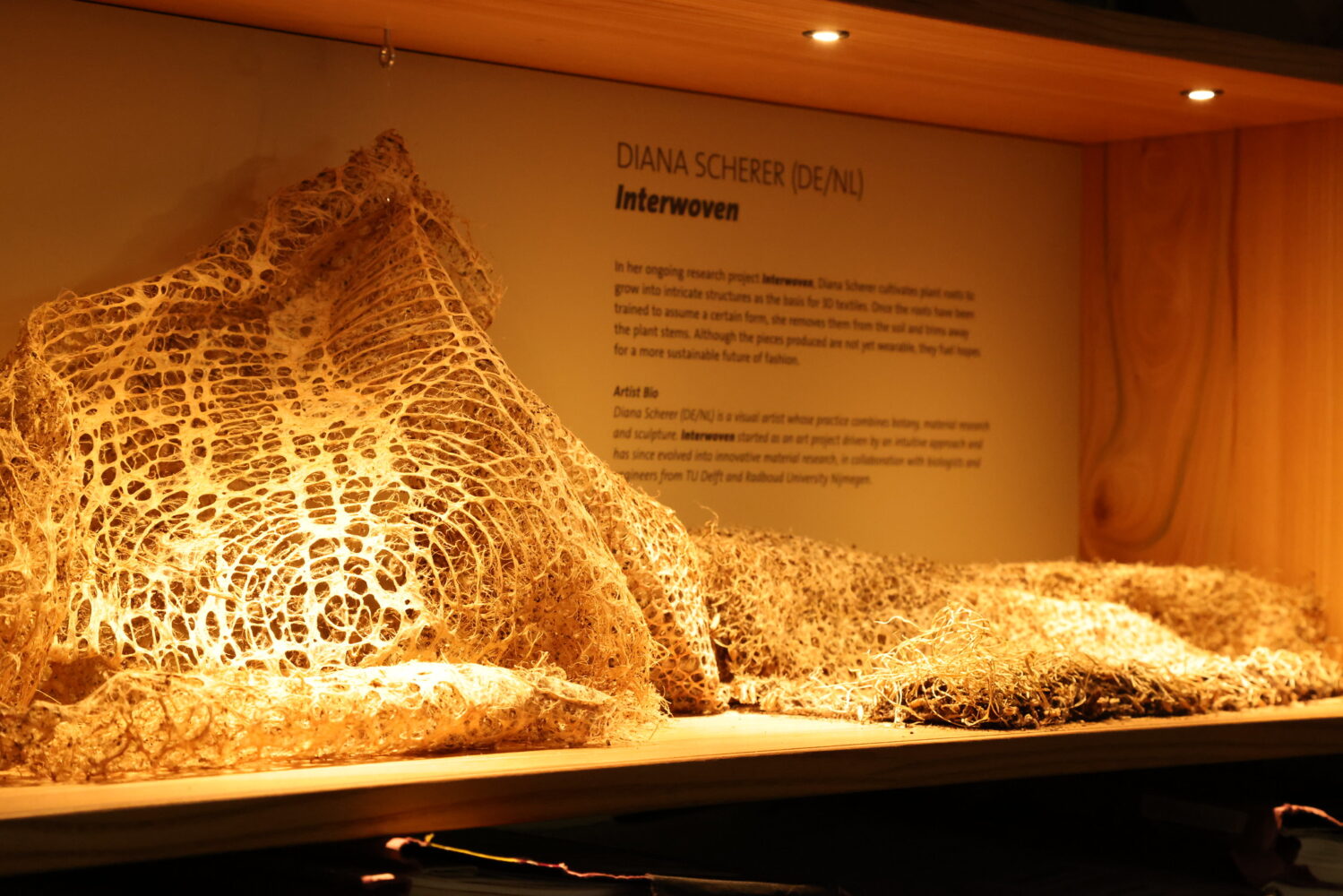
In her ongoing research project Interwoven, Diana Scherer cultivates plant roots to grow into intricate structures as the basis for 3D textiles. Once the roots have been trained to assume a certain form, she removes them from the soil and trims away the plant stems. Although the pieces produced are not yet wearable, they fuel hopes for a more sustainable future of fashion.
Bio
Diana Scherer (DE/NL) is a visual artist whose practice combines botany, material research and sculpture. Interwoven started as an art project driven by an intuitive approach and has since evolved into innovative material research, in collaboration with biologists and engineers from TU Delft and Radboud University Nijmegen.
Tega Brain (AU), Sam Lavigne (US)
Perfect Sleep
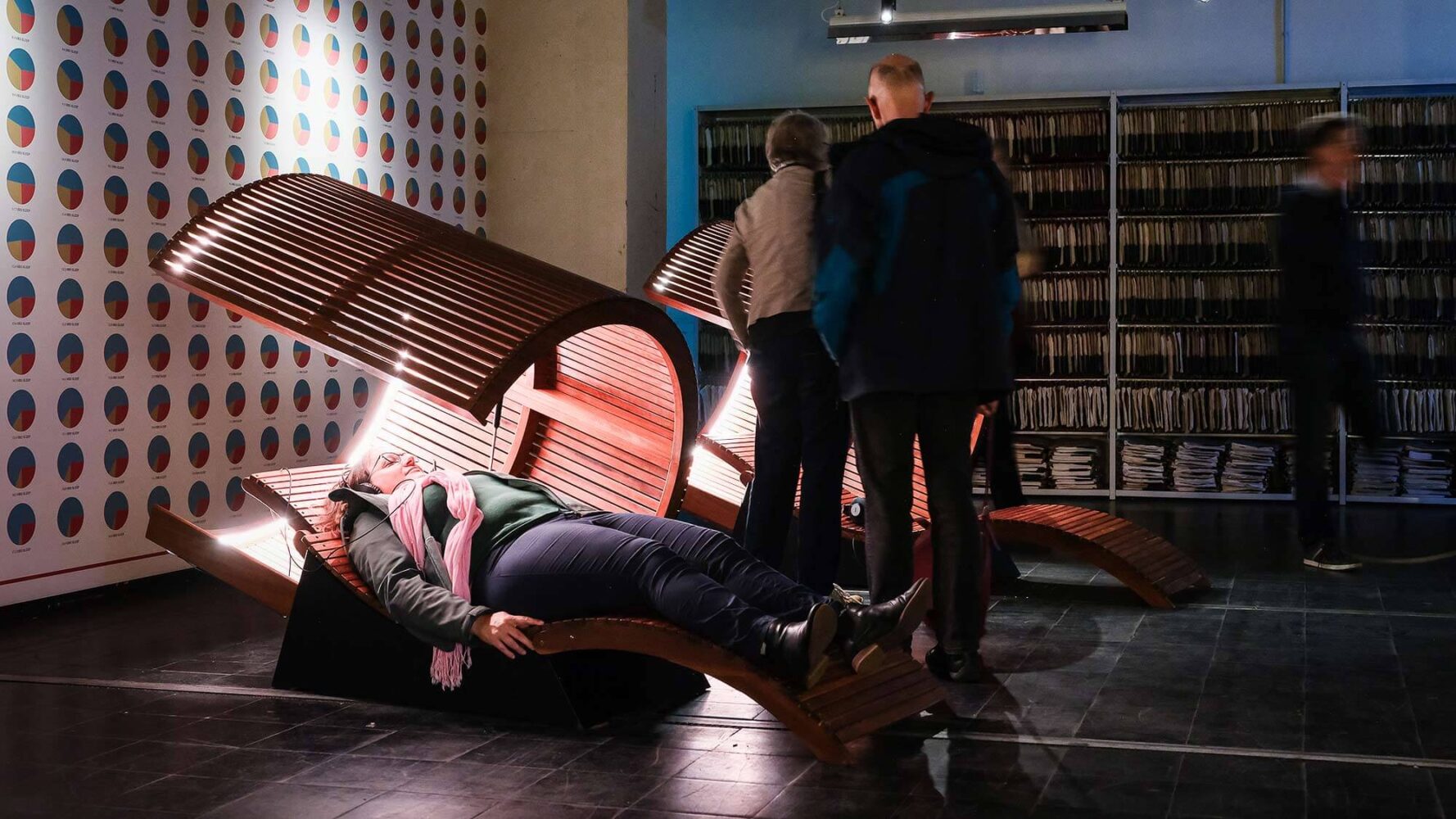
Ever thought of ‘sleep’ as a means of climate engineering? The visitor is invited to lie down and listen to the perspectives of writers, scientists, academics and activists on sleep. The installation Sleep Study includes custom daybeds accompanied by prints that illustrate correlations between sleep and CO2 emissions, GDP, mental health and more. The Perfect Sleep App is available to download and experience anywhere: https://perfectsleep.labr.io/#
Bios
Tega Brain (AU) is an Australian-born artist and environmental engineer known for her work on issues concerning ecology, data systems and infrastructure. She has created wireless networks controlled by environmental phenomena, systems for obfuscating personal data, and a smell-based dating service. Tega is Industry Associate Professor of Integrated Design and Media at New York University, and co-authored her first book, Code as Creative Medium, with Golan Levin.
Sam Lavigne (US) is an artist and educator whose work revolves around themes such as data, surveillance, law enforcement, natural language processing and automation. He is Assistant Professor in the Department of Design at UT Austin. Sam also creates and contributes to open-source software projects for the arts. Previously, he was the Special Projects editor at the New Inquiry magazine.
Artwork Credits & Acknowledgement
Artists: Tega Brain and Sam Lavigne
Dream Incubation texts by Simone Browne, Johanna Hedva, Holly Jean Buck and Sophie Lewis. Sound composed by Luisa Pereira. Furniture designed with Jordana Maisie Design Studio.
Commissioned by the Museum Sinclair-Haus, Stiftung Kunst und Natur, Bad Homburg.
Artist Statement
Perfect Sleep explores the degree to which lack of sleep and global warming are products of the same extractivist economic system, where regeneration, rest and natural limits are devalued. The project comprises a smartphone app and an installation. The Perfect Sleep App enables users to gradually increase their sleep time over three years, aiming to achieve a state of ‘total sleep’. Dream incubation texts by Simone Browne, Johanna Hedva, Holly Jean Buck and Sophie Lewis guide users in envisioning an alternative world during sleep. Composer Luisa Pereira has transformed these texts into dreamscapes. Sleep Study offers custom daybeds on which to experience dreamscapes. The design is inspired by the deck chairs of Thomas Mann’s novel, The Magic Mountain, as well as Silicon Valley sleep pods.
The work also includes an attempt to model climate effects of the user’s changing sleep routine, drawing on research that suggests a correlation between average sleep time, GDP and CO2 emissions. Emission reduction scenarios are presented in relation to different sleep schedules.
Anna Ridler (UK)
Proof of Work

Ever wondered about the actual origin of artificial intelligence datasets? Explore the intricate interplay between data classification and bias systems in automated processes. As tangible datasets sourced from the Thames, shells symbolise the physicality within a digital landscape and spark contemplation of change, flux and interconnectedness in human and natural worlds. The video work documents the laborious process of creating these datasets. Shining a light on the profound significance of a single object turns into a reflection of the world evolving around us.
Bio
Anna Ridler (UK) is an artist and researcher who is fascinated by the use of technologies to understand the world, especially when it comes to measurement, quantification and nature. She uses datasets to craft unique narratives. Her work has been exhibited globally, including in the Barbican Centre, Centre Pompidou, HEK Basel, The Photographers‘ Gallery, ZKM Karlsruhe, Ars Electronica and the Victoria and Albert Museum.
Artist Statement
To the artist, both the act of making and of subsequently revealing are integral aspects of their creative practice. Proof of Work reveals the labour that went into making the dataset for the NFT The Shell Record, and how it was then read by a machine to create synthetic shells. Composing the dataset took several months of finding and collecting shells from various locations along the Thames, one of the largest open archaeological sites in the world. It is possible to see the history of the river in the shells found along its banks.There are numerous oyster shells, although partly as a result of pollution, oysters no longer live in the Thames. They were however prevalent in Victorian, Georgian and even Roman times, not to mention before that too. Meanwhile, new varieties of shells have been transported on various waves of globalisation and along new shipping routes. Scientists observe that the shells of organisms that populated the river since the Ice Age are now rare, in the wake of an influx of invasive species. These new species can in turn be expected to become fossil time-markers of the Anthropocene.
Dorotea Dolinšek (SI)
TerraPort

Inspired by space research, Dorotea Dolinšek has constructed a circular food production machine that enables automated soil enrichment. Though the device is eventually destined for Mars, it has the potential to impact life on Earth right now. Soybeans are planted in regolith (fine stony deposits) and can be observed as they slowly grow. By using her entire body to contribute to soil fertility, the artist adds a decisively feminist perspective. The machine is fully functioning; however, this iteration has been adapted to incorporate coloured liquids that simulate the process.
Bio
Dorotea Dolinšek (SI) is a Ljubljana-based new media artist. She trained as a painter at the Academy of Fine Arts in Venice and is currently working on her Master’s thesis at the Department for Video and New Media at the Academy of Fine Arts and Design in Ljubljana. Through her artistic investigations with a focus on life in the extreme conditions found in outer space, Dorotea draws parallels to surviving the deep ecological crisis on Earth.
Artwork Credits & Acknowledgement
Construction: Jože Zajc | Glass processing: Zvonko Drobnič | Expert advice: Kristijan Tkalec | Light design and technical support: Jure Sajovic, Simon Gmajner | Programming and 3D modeling: Jakob Grčman | Acknowledgments: Robert Černelč, Sašo Sedlaček (Academy of Fine Arts and Design, UL), dr. Marko Flajšman (Faculty of Biotechnology – Department of Agronomy, UL) | Photo: Katja Goliat
Production: Zavod Kersnikova / Galerija Kapelica | Support: Ministry of Culture of the Republic of Slovenia, City Municipality of Ljubljana – Department of Culture
Artist Statement
Advances in space technology stem from our understanding of both interstellar Space and life on Earth. Inspired by the latest efforts in astrobiology and prototypes for terraforming planets envisaged for future human settlement, the artist has developed a machine for automated amelioration of the fine stony deposits on the surface of Mars (“Martian regolith”). Soybeans (Glycine max) are planted in the regolith and nourished with an organic mix of processed human urine, dried menstrual blood and chopped hair. As the regolith travels on the conveyor belt, organic and mineral substances gradually decompose, transforming it into a substrate capable of sustaining microorganisms and plant life.
TerraPort is the first in a series of projects representing the artist’s dedication to addressing the fragility of life on Earth in the face of the current ecological crisis. Through her work, the artist utilises her own body to contribute to the fertility of future interplanetary civilizations.
Quayola (IT)
Unfinished Sculptures – Captives #1
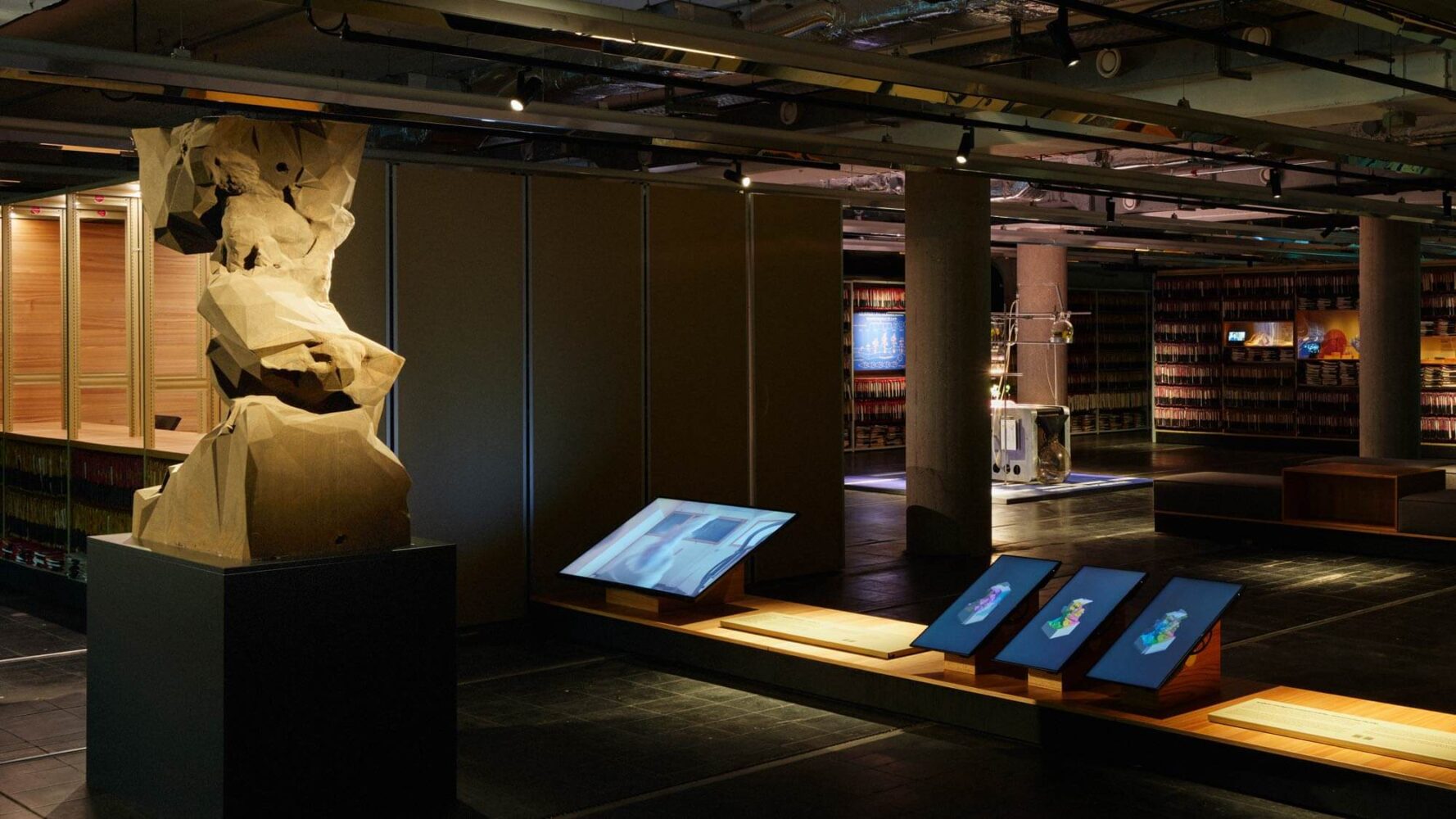
The ongoing research behind Unfinished Sculptures is inspired by Michelangelo’s Prigioni (c. 1510-1530), a series of unfinished sculptures that has become emblematic of the expressiveness embedded in an exposed sculptural process. Meanwhile, as automation becomes increasingly widespread, the way in which we might relate to machines in the near future is coming under scrutiny. Quayola speculates on new robotic sculpting strategies, where technology is no longer so much an instrument of human creativity as a collaborator.
Bio
Quayola (IT) utilises technology as a lens through which to examine the potential tensions and equilibrium between seemingly opposing forces: real and artificial, figurative and abstract, old and new. In his immersive installations, Quayola engages with and re-imagines canonical imagery through his use of contemporary technology.
Artwork Credits & Acknowledgement
Artwork by Quayola
Produced by Quayola Studio
Software Development: Natan Sinigaglia, Matt Swoboda, Julien Vuillet; Sound Design: David Kamp; Z-Brush: James Hardingham; Assistants: Matteo Zamagni, Aymie Backler; Fabricator: Voxeljets
With the support of Ars Electronica and MU Gallery, Eindhoven.
Artist Statement
As a series of sculptures, Captives is a contemporary meditation on Michelangelo’s unfinished series. Whilst referencing Renaissance sculpture, the focus of Quayola’s series shifts from figurative representation to the articulation of matter itself. As in the original Prigioni, Quayola’s unfinished figures document the very history of their creation and transformation. The physical sculpture on display here, Captives #1, was the starting point for Sculpture Factory, an ongoing research-led project on the use of robotics to (re)produce classical sculpture. An accompanying video documents the Sculpture Factory. A large industrial robot live-sculpts endless variations of historical masterpieces. Though never delivering a finished sculpture, each attempt produces new articulations of matter. The result is a hybrid vision – a slow process of discovery that is not focused on reproducing any given original artwork of the Renaissance, but rather on the infinite possibilities involved in attempting to do so.
Deep vision – immersive exhibition
The development of digital imaging technologies has unquestionably altered and expanded our perception of the world. New scope for transforming abstract concepts into information that can be presented and communicated has essentially redefined our understanding of the world. Deep vision is a multifunctional media space for innovative forms of education, training and entertainment, as well as for new means of presentation and artistic forms of expression. Deep vision serves as a prototype for navigating the convergence of emergent possibilities, unique forms of representation and accompanying technical and societal challenges. Its technical equipment and content orientation are designed to explore this intersection. Drawing inspiration from the immersive Deep space concept at the Ars Electronica Center, Deep vision showcases three captivating projects: Made to Measure as well as Gigapixel Editions and Pulse of the EPO, two digital EPO commissions.
Deep vision projects:
- Pulse of the EPO / Quadrature (DE)
- Made to Measure / Laokoon: Cosima Terrasse (FR), Moritz Riesewieck (DE) and Hans Block (DE)
- Gigapixel Editions – the EPO’s high-resolution digitalised art archive / Ars Electronica (AT)
Quadrature (DE)
Pulse of the EPO

Pulse of the EPO is inspired by the EPO’s vast databases. It visualises the evolution of patent data over the past 50 years by giving expression to technology trends and the direction of innovation in Europe and beyond. In several short stories of one or two minutes each, Pulse of the EPO reflects upon the European Patent Office’s profound impact on processes of global transformation.
Bios
Berlin-based artist duo Quadrature focuses on the use of data and technology to read and write realities. Their transdisciplinary approach spans time-based performance, installations, classical sculpture and two-dimensional works. They explore the world and cosmos, employing various methods and narratives. The members Juliane Götz and Sebastian Neitsch (formerly together with Jan Bernstein until 2016) have received recognition from Prix Ars Electronica, Kunstfonds Bonn, Akademie Schloss Solitude, LaBecque, PODIUM Esslingen, and Hertz-lab at the ZKM Karlsruhe.
Artwork Credits & Acknowledgement
Original Artwork: Quadrature
Commissioned by the European Patent Organisation in the framework of the Ars Electronica exhibition Catalyst Lab 2023
Artist Statement
Pulse of the EPO foregrounds the transformative power of creativity in science and technology. Its raw material: the vast amounts of technical information and documents that the EPO safeguards as part of the organisation’s mission to foster innovation, competitiveness and economic growth. This artwork presents a series of narratives reflecting the EPO’s global impact. True-to-data approaches mix with subjective speculation and poetic freedom. The immense volume of data provides the primary inspiration, detached from any underlying background — naked data to be processed, refined or mixed.
Various parameters from the EPO’s databases shape the work’s aesthetics and dramaturgy, including for example the patent application’s date of filing and country/place of origin, the applicant themselves, the time between filing and grant/refusal, the number of citations of a patent application, technical fields, application titles, status events, patent families and many more. In each individual narrative, sound and image are generated simultaneously, all based on the EPO’s data sets. These data sets convey further patent intelligence too, including on the hundreds of thousands of innovations that are tagged as climate mitigation and adaptation technologies.
Laokoon: Cosima Terrasse (FR), Moritz Riesewieck (DE) and Hans Block (DE)
Made to Measure
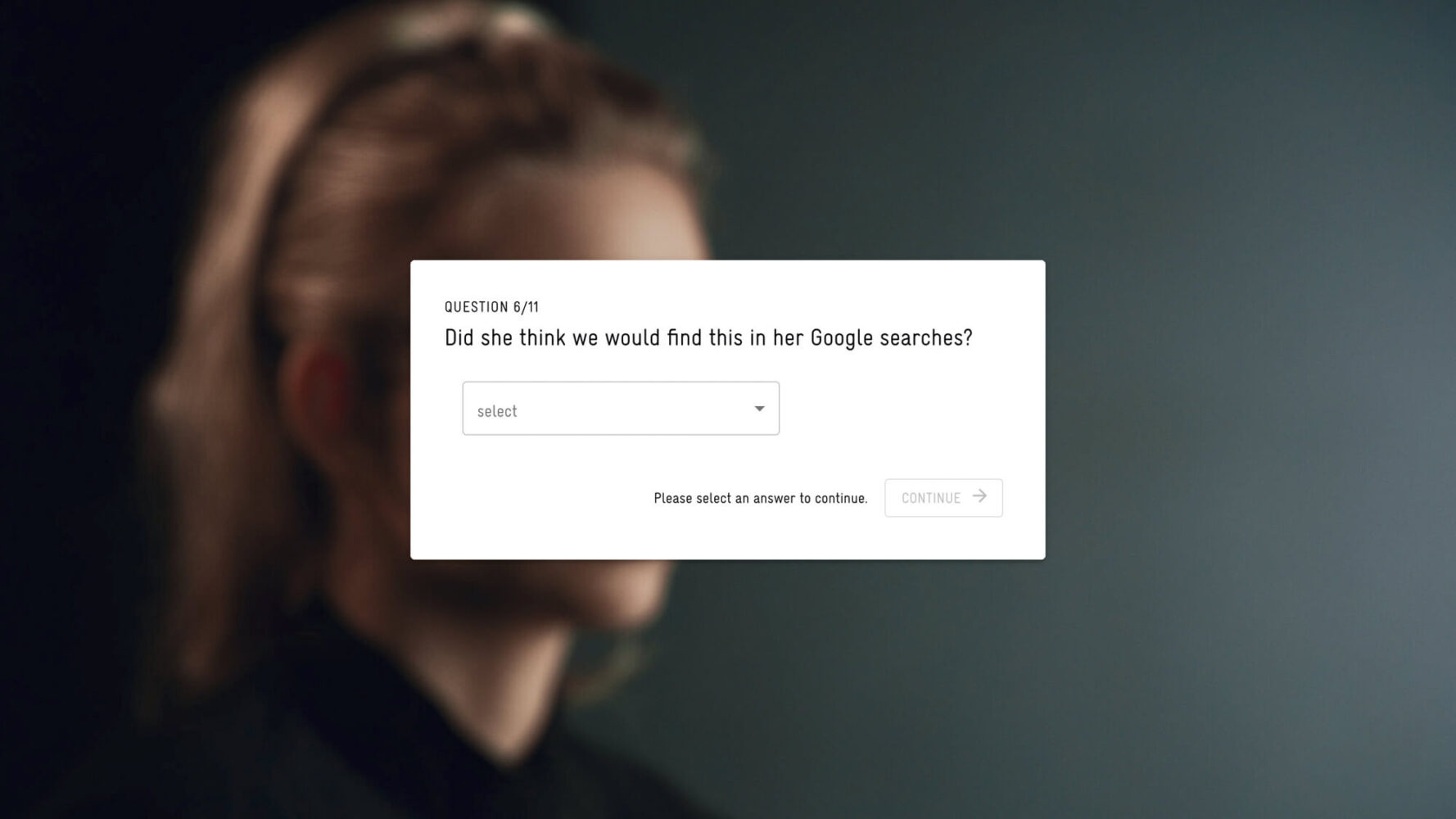
Knowledge is power. And today, as data equals knowledge, data is power. Every day we leave significant traces of personal information on the internet. Laokoon has taken on the challenge of reconstructing a person solely based on these traces, by using their Google search data. The result is a three-channel video installation that encourages viewers to reflect on their online behaviour and consider the use of tools to protect their privacy.
Bios
Laokoon, which consists of Cosima Terrasse (FR), Hans Block (DE) and Moritz Riesewieck (DE), is an Emmy-nominated cross-media group based in Berlin and Vienna. They are renowned for their immersive experiences and TV documentaries, which explore the intersection of technology and society.
Artwork Credits & Acknowledgement
Direction: Cosima Terrasse, Moritz Riesewieck, Hans Block
Development: Gruppe Laokoon, Kulturstiftung des Bundes
In coproduction with: WDR, SRG SSR, OSZE RfOM, Docmine and rbb
In cooperation with: PACT Zollverein
With support from: Kulturhaus Brotfabrik, vorAnker, Universität für Angewandte Kunst Wien, Starts in Motion and with kind support of the German Embassy.
Artist Statement
As part of an artistic data experiment, Laokoon created a doppelganger solely by using the personal Google data of an unknown person. Five years of that person’s life were meticulously reconstructed and filmed on a theatre stage. Months later, the person met her ‘datafied’ double. This spectacular, one-of-a-kind experiment is brought to life in a film and interactive storytelling website. Here, visitors can experience just how far-reaching the insights into our inner lives and most intimate secrets are, which we ourselves enable Google, Facebook and other online platforms to acquire every day.Tapping into an innovative and intricate digital narrative format, the cross-media project Made to Measure, which also includes a TV documentary, sheds light on how tech companies exploit data collected from billions of people, including to turn their weaknesses, insecurities, illnesses and susceptibility to addiction into profit.
Ars Electronica (AT)
Gigapixel Editions –
the EPO’s high-resolution digitalised art archive

Artworks from the EPO art collection were digitally archived with the use of very high-resolution photography and digital image mosaics. For each artwork, this enabled multiple high-resolution images to be arranged in a single digital representation of the work, revealing details that would previously have gone unnoticed. Paul Leitner’s Sucrologist (2016), Afra Eisma’s Noonday Sun (2019) and Ivan Šuletić’s CFRP Cityscape XI (2019) are the first three artworks from the collection that can be experienced here in this way.
Bios
Paul Leitner (AT) lives and works in Vienna, where he graduated from the University of Applied Arts in 2011. He turns everyday objects and apparatus into subtle and sophisticated artworks, which often take the form of multidimensional installations.
Afra Eisma (NL) studied fine art at the Royal Academy of Arts in The Hague and at Central Saint Martins in London. She mainly works with textiles and ceramics to create bright, colourful, immersive installations, complete with hidden messages and a distinctive emotion.
Ivan Šuletić (RS) lives and works in Belgrade, where he received a Doctor of Fine Arts degree from the Faculty of Fine Arts in 2015. As well as working and exhibiting widely as a visual artist, he is an assistant professor at the city’s Faculty of Architecture.
Artwork Credits & Acknowledgement
Production and editing: Ars Electronica
Gigapixel photography: Florian Voggeneder
Sound and music: Karl Julian Schmidinger
Original artworks: Paul Leitner Sucrologist (2016), Afra Eisma Noonday sun (2019), Ivan Šuletić CFRP Cityscape XI (2019)
Commissioned by the European Patent Organisation in the framework of the Ars Electronica exhibition Catalyst Lab 2023
Artist Statement
The initial offering of Gigapixel Editions explores the aesthetics of collecting, weaving and painting as captured in a digital archive, with each of the three artworks reproduced in around a billion pixels. This level of detail only emerged in digital photography during the last decade, opening up new territory for curators and art scholars as well as the general public, who thanks to this new technology can now view selected artworks online in greater detail than in most traditional exhibition spaces.
The glorious detail of the sugar sachets in Paul Leitner’s artwork Sucrologist (350 x 200 cm), which are adorned with a tremendous variety of designs and alphabetic scripts, is revealed as never before. Afra Eisma’s loving and spontaneous tapestry is the next largest work of the three and by far the most colourful, suggesting a street-art aesthetic in woven form. Ivan Šuletić’s slightly smaller oil painting (200 x 180 cm) completes the cycle. Using a found digital image of a place he never visited as his point of departure, the artist experiments with an almost mechanical, depersonalised way of painting and drawing cityscapes in an age dominated by endless digital odysseys and social media feeds.
Partner and Venue
European Patent Office (EPO)
One of Europe’s largest public service organisations, the EPO helps inventors, researchers and companies around the world protect their inventions. Our overall goal is to contribute to a safer, smarter, more sustainable world by fostering innovation, competitiveness and economic growth. Established in 1973 with the signing of the European Patent Convention, we also provide access to the world’s largest single source of technical information, which can help accelerate innovators’ discoveries.
Exhibition Venue
The European Patent Office is opening a cultural space in the revitalised basement at the Munich headquarters this year. Housed in the former patent file archive, it provides a site for artists, historians, EPO staff and stakeholders to reflect, together with the broader public, on the role of technology in society. With exhibitions that explore the past, present and future of art and innovation, the space invites visitors to discover the impact of new discoveries throughout time.
Credits
Team Ars Electronica
Curator: Martin Honzik
Co-Curator and Producer: Laura Welzenbach
Producer: Veronika Krenn, Daniela Duca De Tey and Manuela Hillmann
Tech Lead: Karl Julian Schmidinger and Klaus Dieterstorfer
Tech Team: Klaus Dieterstorfer, Florian Cossee and Randolf Helmstetter
Exhibition Design: ANY:TIME Architekten
Editor: Julia Blaas
Special thanks to
The artists of the exhibition and their assistants and supporters.
The Ars Electronica team and in particular to Veronika Liebl, Christl Baur, Katia Kreuzhuber, Martin Hieslmair, Gregor Tatschl, Christopher Sonnleitner, Gerfried Stocker, Markus Jandl, Stephan Kobler, Barbara Diesenreither.
The EPO team and in particular to EPO President António Campinos for enabling the exhibition.

